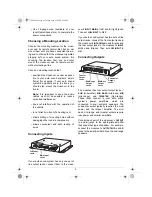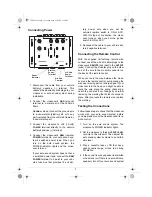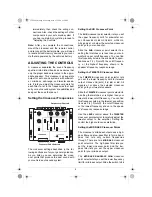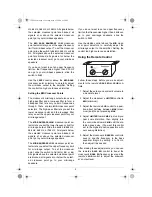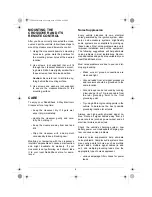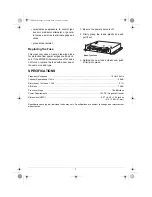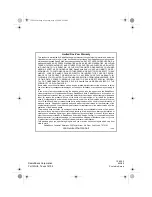
6
MOUNTING THE
CROSSOVER AND ITS
REMOTE CONTROL
After you have correctly connected the cross-
over and set the controls, follow these steps to
mount the crossover and its remote control.
1. Using the crossover's/remote’s mounting
holes as a guide, mark the positions for
the mounting screw holes at the desired
location.
2. Use screws (not supplied) that will fit
through the crossover’s/remote’s mount-
ing holes. Drill a hole slightly smaller than
these screws at each marked position.
Caution: Be careful not to drill into any-
thing behind the mounting surface.
3. Use screws and washers (not supplied)
to secure the crossover/remote to the
mounting surface.
CARE
To enjoy your RadioShack 4-Way Electronic
Crossover for a long time:
• Keep the crossover dry. If it gets wet,
wipe it dry immediately.
• Handle the crossover gently and care-
fully. Do not drop it.
• Keep the crossover away from dust and
dirt.
• Wipe the crossover with a damp cloth
occasionally to keep it looking new.
Modifying or tampering with the crossover’s
internal components can cause a malfunction
and might invalidate its warranty. If your
crossover is not performing as it should, take
it to your local RadioShack store for assis-
tance.
Noise Suppression
Every vehicle produces its own electrical
noise generated by the ignition system, alter-
nator, and accessory systems. High-fidelity
audio systems are susceptible to picking up
these noises. Most noise problems are due to
improper installation and not the equipment.
The following suggestions will help eliminate
noise problems in most installations. Recom-
mended cables and parts are available at your
local RadioShack store.
Most noise problems are due to poor and im-
proper grounding.
• Make sure all ground connections are
clean and tight.
• Ground leads from all signal processors
and receivers should be grounded to the
same location.
• Ground loops can be reduced by running
a low-gauge (8 or 10) ground cable from
the rear grounding point to the front
grounding point.
• Try using different grounding points in the
vehicle to determine the best possible
grounding location for all units.
Always use high-quality shielded signal ca-
bles. Route all signal cables away from all
power sources (such as power wires) and all
electrical motors and devices.
Check the vehicle's charging system. Low
battery power or an inadequate charging sys-
tem can cause noise problems.
External noise suppressors help eliminate
noise problems. Complex audio systems have
many entry points for noise, such as multiple
power leads, multiple signal cables (in and
out), and multiple grounding leads. Use the
appropriate type of noise suppressor:
• various amperage filter chokes for power
leads
12-2020.fm Page 6 Tuesday, May 23, 2000 6:56 PM


